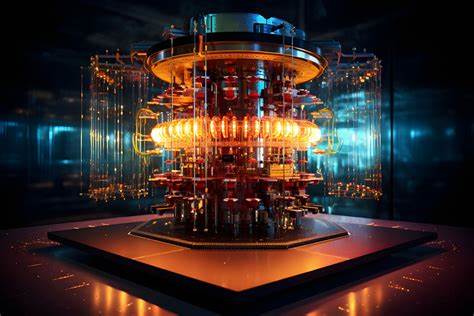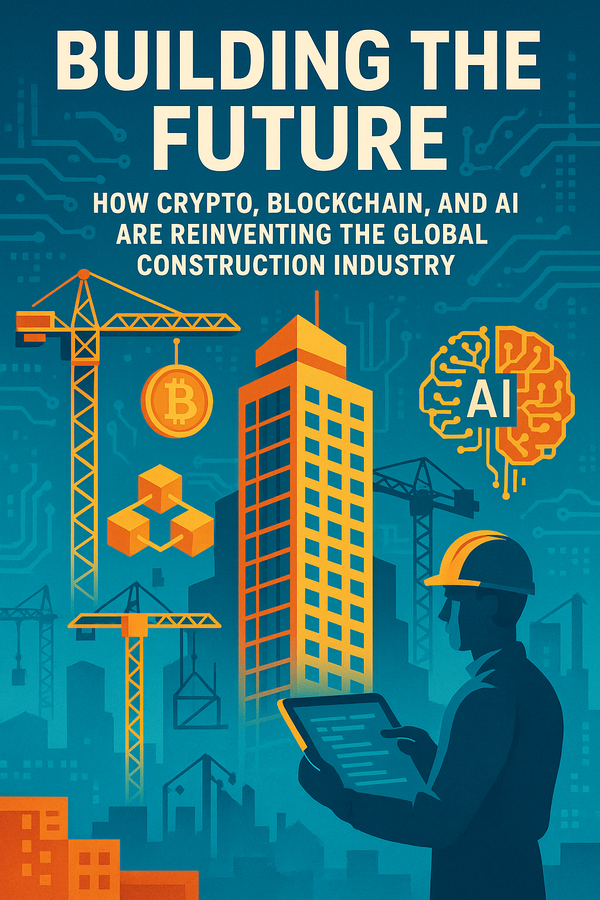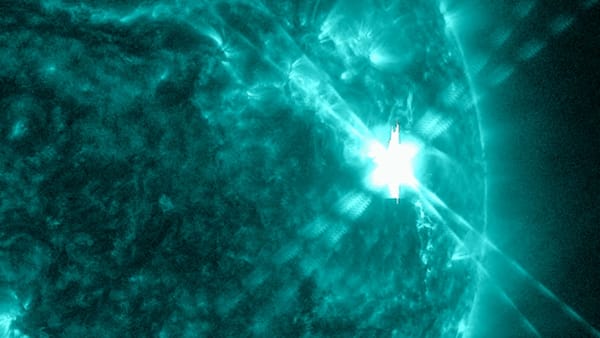(FREE) The Quantum-AI Nexus: How Next-Gen Computation Will Reshape Crypto

In the race to define the digital future, two technologies stand poised to revolutionize everything we know: quantum computing and artificial intelligence. Each is powerful on its own, but when combined, their potential is not merely additive, it’s exponential. For the crypto ecosystem, this convergence is both an existential challenge and a once-in-a-generation opportunity.
This article delves into how quantum computing and AI are intersecting to shape the future of cryptography, trading, blockchain infrastructure, decentralized governance, and digital identity. As the CryptoSazz readership positions itself at the bleeding edge of innovation, understanding these dynamics is no longer optional, it's essential.
Part I: Understanding the Building Blocks
What is Quantum Computing?
Quantum computing leverages the laws of quantum mechanics—superposition, entanglement, and quantum interference—to process information in ways classical computers cannot. Where classical bits are binary (0 or 1), quantum bits or qubits can represent both states simultaneously.
This allows quantum computers to:
- Factor large numbers exponentially faster (breaking RSA or ECC encryption)
- Simulate complex physical systems (e.g., molecular interactions)
- Solve optimization problems beyond classical reach
Quantum supremacy has already been demonstrated for narrow applications. But crypto’s Achilles' heel lies in what’s coming next: quantum practicality.
What is Artificial Intelligence (AI)?
AI, particularly in its machine learning and deep learning forms, excels at pattern recognition, prediction, and decision-making under uncertainty. With the rise of foundation models (e.g., GPT, Gemini, Claude), AI is not only smarter—it’s increasingly autonomous.
In finance, AI is already used to:
- Predict price patterns
- Optimize portfolios
- Detect fraud
- Automate trading
But when paired with quantum hardware, AI models could leapfrog current limits in both data capacity and learning efficiency.
Part II: The Threat Vector – Breaking Crypto’s Security Bedrock
Quantum vs. Cryptography
Much of crypto's security relies on cryptographic assumptions that quantum computers threaten to unravel.
Vulnerable primitives:
- RSA (used in Bitcoin wallets and SSL): Can be broken by Shor’s algorithm in polynomial time.
- ECDSA (used in Ethereum and most modern wallets): Also breakable with enough quantum resources.
Current blockchains depend on the hardness of problems like integer factorization or discrete logarithms. These are tractable for quantum computers. A large enough quantum computer could:
- Derive private keys from public keys (e.g., compromised wallets)
- Forge transactions or signatures
- Break consensus mechanisms that rely on digital signatures
Timeline:
Estimates suggest that a quantum machine with 4,000+ stable qubits could break ECDSA. As of mid-2025, IBM and Google have demonstrated ~1,000 qubit systems—but still with high error rates.
Implication:
Within the next 5–10 years, most public blockchains may need a cryptographic migration, or face irrelevance.
Part III: The Counterforce – Quantum-Resistant Crypto
Post-Quantum Cryptography (PQC)
In response, NIST has already selected several PQC algorithms. Crypto protocols will need to migrate to:
- Lattice-based encryption (e.g., CRYSTALS-Kyber, Dilithium)
- Multivariate-quadratic signature schemes
- Hash-based schemes (e.g., XMSS, SPHINCS+)
This won’t be easy.
Challenges include:
- Larger key sizes (up to 10x more storage/bandwidth)
- Backward compatibility with older keys
- Coordinated chain-wide upgrades
Opportunities:
- A new wave of “quantum-native” Layer 1 blockchains (e.g., QANplatform, PQShield)
- Smart contract frameworks that embed PQC from inception
- Wallets that auto-rotate to quantum-safe keys
Projects that can secure their stack preemptively will earn institutional trust—and long-term capital flows.
Part IV: AI’s Role in the Quantum Transition
AI-Enhanced Security Audits
AI models, especially transformers trained on Solidity and cryptographic libraries, can:
- Audit smart contracts for vulnerabilities
- Identify hash collisions or entropy leaks in key generation
- Simulate adversarial quantum attack surfaces
As quantum-era cryptographic complexity increases, AI will become critical for:
- Automated pen-testing of contracts and wallets
- Stress-testing consensus against quantum threats
- Recommending safe key upgrade pathways
AI for Smart Key Management
Quantum-safe keys may be unwieldy. AI agents can:
- Manage post-quantum key hierarchies across wallets and devices
- Monitor signature entropy for anomalies
- Schedule upgrades with zero-downtime rotation
This "autonomous security mesh" could be a killer app for institutional crypto custody.
Part V: Quantum + AI = Superintelligent Trading Agents
Quantum AI in Market Prediction
The holy grail of trading is prediction. Quantum AI—AI models trained or run on quantum computers—may unlock entirely new trading strategies.
Potential capabilities:
- Non-linear feature entanglement: Quantum-enhanced models can correlate features (e.g., sentiment, volume spikes, wallet behavior) in ways classical systems can’t.
- Superposition-based simulations: Run thousands of market scenarios simultaneously to find optimal path-dependent trades.
- Quantum Bayesian Networks: Better modeling of uncertainty in chaotic markets.
Reinforcement Learning on Quantum Hardware
Quantum-enhanced reinforcement learning (QRL) agents could:
- Learn optimal crypto trading policies from sparse, noisy data
- Exploit short-lived arbitrage windows with reduced latency
- Adapt in real-time to market structure shifts (e.g., when a whale moves funds)
These agents could become sovereign market actors—learning, adapting, and outperforming human traders.
Part VI: Re-Architecting the Blockchain Stack
Quantum AI-Driven Consensus Mechanisms
Blockchains today depend on brute-force (PoW) or economic stake (PoS) assumptions. But quantum AI could birth new consensus mechanisms.
Examples:
- Proof of Entropy: Validators demonstrate quantum-generated randomness verified by zk-SNARKs
- AI-Moderated DAOs: Governance decisions optimized by large language models and quantum simulations
- Intent-Based Execution: AI agents interpret user intent and submit the optimal transaction bundle (rather than the user specifying exact actions)
This breaks from the “user-as-miner” paradigm and unlocks more fluid economic logic.
Quantum-Orchestrated Interoperability
As the number of chains explodes, bridging becomes critical—and risky.
Quantum AI agents could:
- Route transactions across chains probabilistically to minimize slippage
- Detect bridge vulnerabilities before exploits
- Automatically rebalance liquidity across ecosystems based on predictive demand flows
Cross-chain DeFi, secured by quantum-AI arbitrageurs, could become the new high-frequency finance.
Part VII: Digital Identity, Privacy & Surveillance
Quantum and Zero-Knowledge Proofs (ZKPs)
ZKPs are critical to private DeFi, identity, and compliance. But many ZK schemes rely on cryptographic assumptions vulnerable to quantum attack.
Quantum AI can help in two ways:
- ZKP migration: AI can assist in rewriting ZK circuits with lattice-based or quantum-hard assumptions.
- Anomaly detection: AI agents can monitor for privacy-breaking patterns (e.g., MEV bots extracting ZK transaction metadata)
Projects like Aleo, Aztec, and zkSync must consider post-quantum privacy frameworks or risk becoming obsolete.
AI and Decentralized Identity (DID)
Web3 identity is moving toward decentralized verification via DID standards. AI will enable:
- Real-time identity scoring based on behavior, biometrics, and zero-knowledge credentials
- On-chain reputation systems using language models to interpret user activity
- Contextual access control (e.g., “allow this DAO vote only if user has staked > 1000 tokens and passed a KYC-L2 test”)
Quantum-secure identity will be essential to prevent deepfake attacks and credential forgeries in a machine-mediated future.
Part VIII: Geopolitics, Regulation & the Quantum-AI Arms Race
National Security & Crypto
Quantum supremacy will have massive geopolitical consequences. If China, the US, or any actor achieves practical quantum decryption first, they could:
- Read encrypted messages
- Sweep compromised crypto wallets
- Subvert privacy coins
Crypto assets would become a national security domain. Expect:
- More regulation of quantum threat disclosures (e.g., by exchanges and custodians)
- State-mandated key rotation schedules
- Secure enclave mandates for AI-crypto systems
Institutional Adoption & Infrastructure
As BlackRock, Fidelity, and sovereign wealth funds move deeper into crypto, quantum-AI compatibility will become a due diligence line item.
Winning protocols will be:
- Post-quantum secure (end-to-end)
- AI-optimized (real-time analytics, anomaly detection)
- Modular (upgradable without hard forks)
Those who fail to evolve risk being delisted, deprecated, or forgotten.
Part IX: Investment Implications & Alpha Zones
Quantum-Native Startups to Watch
- QANplatform: Building quantum-resistant Layer 1 with hybrid cloud/quantum support.
- Classiq: Quantum algorithm synthesis—useful for simulating market structures.
- SandboxAQ (Alphabet spinout): Working on quantum AI + encryption for finance and healthcare.
Infrastructure Layers with Asymmetric Payoff
- Data availability layers (e.g., Celestia) enhanced by AI summarization
- Validator marketplaces that include quantum-proof slashing conditions
- Real-world asset (RWA) protocols with embedded post-quantum ID verification
The key is to invest in meta-structures that will be required in a quantum-AI world—regardless of Layer 1 winners.
Part X: Philosophical & Existential Questions
Autonomy vs. Authority
In a world where AI agents govern liquidity, allocate capital, and enforce cryptographic law—what role does the human play?
- Will DeFi be ruled by DAO-AIs that outvote humans?
- Will smart contracts write themselves, adapting in real time?
- Will quantum agents anticipate market moves before they happen?
The crypto ethos of decentralization must grapple with a new force: machine sovereignty.
The Singularity on the Blockchain
The convergence of quantum computing and AI is often called “the Singularity.” When it meets crypto, we may get:
- Self-owning protocols that evolve via smart Darwinism
- Governance systems that optimize for the long-term survival of economic primitives
- Cryptographically enforced ethics (e.g., smart contracts that ban CO2-intensive activity)
We are building more than money—we are building digital minds that may someday run the economy.
Final Thoughts: Prepare or Perish
The age of classical crypto is ending.
In its place will rise a new world:
- Quantum-proof by necessity
- AI-native by design
- Governed by intent, not just code
Crypto investors, developers, and institutions must prepare for this shift now. It is no longer sufficient to ask, “Will AI or quantum affect crypto?” The better question is: “How can we shape crypto to harness their full potential—before someone else does?”
The winners of the next cycle won’t just be early. They’ll be ready.
✍️ By CryptoSazz Research Team
The content provided on CryptoSazz is for informational and educational purposes only and does not constitute financial, investment, trading, or other advice. Nothing on this site is a recommendation or solicitation to buy or sell any financial asset or to adopt any investment strategy.
CryptoSazz may discuss market trends, macroeconomic developments, and quantitative trading models; however, these are intended solely to share insights and analysis and are not tailored to your specific financial situation or investment objectives.
While we strive to ensure the accuracy and timeliness of the information presented, CryptoSazz makes no warranties or representations regarding its completeness or reliability. All opinions expressed are subject to change without notice.
Cryptocurrencies, DeFi protocols, and digital assets involve significant risk, including the potential loss of principal. You should conduct your own research and consult a qualified financial advisor before making any investment decisions.
Past performance is not indicative of future results.




